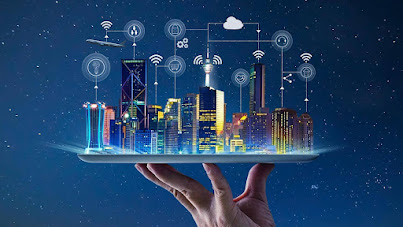Featured
- Get link
- X
- Other Apps
Benefits of Smart Cities And, More
Smart cities are those that use information and message technologies (ICT) to improve the quality of life, efficiency of urban operations, and services for their citizens. They are designed to be more sustainable, livable, and resilient.
There are many benefits to smart cities, including:
Improved efficiency and productivity: Smart cities can use
ICT to automate tasks, optimize resources, and improve efficiency. This can
lead to cost savings and productivity gains for businesses and governments.
Improved quality of life: Smart cities can use ICT to
improve the quality of life for citizens in a number of ways. For example, they
can use sensors to monitor traffic and optimize transportation, or they can use
data analytics to improve public safety.
Increased sustainability: Smart cities can use ICT to reduce
their environmental impact. For example, they can use sensors to monitor energy
usage and optimize it, or they can use renewable energy sources.
Enhanced security: Smart cities can use ICT to improve
security and resilience. For example, they can use sensors to monitor crime and
respond to incidents more quickly, or they can use data analytics to predict
and prevent disasters.
Increased civic engagement: Smart cities can use ICT to
increase civic engagement and improve communication between citizens and
government. For example, they can use online platforms to allow citizens to
participate in decision-making, or they can use social media to get feedback
from citizens.
Of course, there are also some challenges associated with
smart cities. These include:
The cost of implementation: Smart cities can be expensive to
implement, especially for developing countries.
The security of data: Smart cities collect a lot of data about citizens, which raises concerns about data security and privacy.
Overall, the benefits of smart cities outweigh the
challenges. Smart cities have the potential to make our cities more efficient,
sustainable, and livable. However, it is important to carefully consider the
challenges before implementing smart city technologies.
Here are some specific examples of the benefits of smart
cities:
Intelligent traffic management: Smart cities can use sensors
and data analytics to optimize traffic flow, reduce congestion, and improve air
quality. For example, the city of Barcelona has used smart traffic management
to reduce traffic congestion by 20%.
Smart water management: Smart cities can use sensors to
monitor water usage and leaks, and they can use data analytics to optimize
water distribution. For example, the city of Singapore has used smart water
management to reduce water consumption by 30%.
Smart waste management: Smart cities can use sensors to
track waste collection and disposal, and they can use data analytics to
optimize waste management. For example, the city of San Francisco has used
smart waste management to reduce waste by 10%.
Smart lighting: Smart cities can use sensors to dim or
brighten streetlights based on traffic levels, and they can use data analytics
to optimize energy usage. For example, the city of New York City has used smart
lighting to reduce energy consumption by 25%.
These are just a few examples of the many benefits that
smart cities can offer. As smart city technologies continue to develop, we can
expect to see even more benefits in the future.
Whether or not we need smart city advantages depends on a
number of factors, including the specific needs of the city, the resources
available, and the potential benefits and risks.
Risks of smart cities
However, there are also some risks associated with smart
cities, including:
The cost of implementation: Smart cities can be expensive to
implement, especially for developing countries.
The security of data: Smart cities collect a lot of data
about citizens, which raises concerns about data security and privacy.
The digital divide: Smart cities rely on ICT, so there is a
risk of widening the digital divide between those who have access to technology
and those who don't.
The potential for misuse: Smart city technologies could be
misused by governments or corporations to track citizens or control their
behavior.
Future Directions of smart cities
The future of smart cities is full of promise, with the
potential to improve the quality of life for citizens and make our cities more
sustainable. Here are some of the future directions of smart cities:
The rise of 5G and beyond: 5G and beyond will enable even
more connected devices and applications, which will open up new possibilities
for smart cities. For example, 5G could be used to power self-driving cars,
smart healthcare, and real-time traffic management.
The growth of artificial intelligence (AI): AI is already
being used in smart cities for a variety of tasks, such as traffic management,
energy optimization, and crime prevention. In the future, AI is likely to play
an even greater role in smart cities, helping to make them more efficient,
sustainable, and livable.
The development of new technologies: As new technologies emerge,
they will be adopted by smart cities to improve the lives of citizens. For
example, blockchain could be used to secure data and transactions in smart
cities, while augmented reality could be used to provide information and
services to citizens in real time.
The focus on citizen engagement: Smart cities will
increasingly focus on citizen engagement, ensuring that citizens have a say in
how their city is managed. This could be done through online platforms, social
media, or even physical spaces where citizens can come together to discuss and
debate issues.
Conclusion
Whether or not we need smart city advantages depends on a
number of factors. However, the potential benefits of smart cities are
significant, and they could help to make our cities more efficient,
sustainable, and livable. It is important to weigh the benefits and risks
before deciding whether or not to implement smart city technologies.
- Get link
- X
- Other Apps
Popular Posts
Energy audits: Conducting strength audits can assist become aware of and rectify areas of inefficiency
- Get link
- X
- Other Apps

